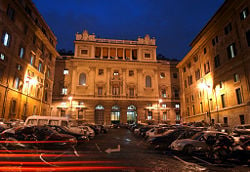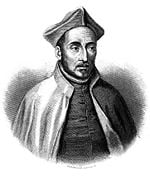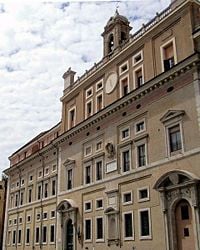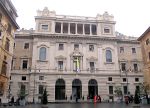Difference between revisions of "Gregorian University" - New World Encyclopedia
Nick Perez (talk | contribs) |
Rosie Tanabe (talk | contribs) |
||
| Line 125: | Line 125: | ||
==External links== | ==External links== | ||
| − | *[http://www.unigre.urbe.it/ The Pontifical Gregorian University Official Site] (in Italian) | + | |
| − | + | *[http://www.unigre.urbe.it/ The Pontifical Gregorian University Official Site] (in Italian) Retrieved December 22, 2007. | |
| + | |||
Revision as of 19:51, 22 December 2007
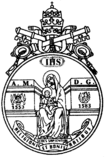
| |
| Motto | Religioni et Bonis Artibus (Latin: "For Religion and Culture") |
|---|---|
| Established | 1551 |
| Type | Private, Catholic, Jesuit, Pontifical |
| Location | Rome, Italy, but partially extraterritorial of the Holy See
|
| Website | http://www.unigre.it |
Pontifical Gregorian University (Italian: Pontificia Università Gregoriana) is a pontifical university located in Rome, Italy. Heir of the Roman College, the Gregorian University is one of the oldest universities in the world today, and was the first Jesuit University in the world, being founded by St Ignatius of Loyola over 450 years ago. Containing faculties and institutes of various disciplines of the humanities, the Gregorian has one of the largest theology departments in the world, with over 1600 students from over 130 countries.
Mission and Reputation
On the Gregorian University's website, the page of Intent states several missions of the school, the most important being the universities assistance to Catholic churches all over the world.[1] To accomplish this end, the university educates its members to the fullest extent of Catholic tradition, but also prides itself in incorporating certain elements of liberal arts and sciences. The stated purpose of this is to both deepen the student's understanding of God through new scientific breakthroughs as well as to give them an understanding of some of the modern arguments against belief in God. By incorporating such worldly perspectives with traditional teachings of dogma, the university hopes to produce church members and workers who are secure in their faith and conviction as well as capable of living and working in the modern world.[2]
Within the Catholic faith, the Gregorian University has an excellent reputation for transmitting discipline, knowledge and tradition to its students. Because of its vast collections and historical origins, it is also regarded as an excellent academic school. Most of its students upon graduating either become scholars or clergy members.
History
St. Ignatius of Loyola, founder of the Society of Jesus (Jesuits), with financial patronage from Cardinal St. Francis Borgia founded a "school of grammar, humanity, and Christian doctrine" on February 18, 1551 in a house at the base of the Capitoline Hill.[3] With a small library connected to it, this school was called the Collegio Romano (Roman College). Within the first year, due to the number of students, the site was transferred to a larger facility behind the church of San Stefano del Cacco. After only two years of existence, the Roman College already counted 250 alumni.
In January of 1556, Pope Paul IV gave the College the faculty to confer academic degrees in theology and philosophy, thereby raising the school to the rank of university.[4] During the following two decades, due once again to an increased number of students, the university changed seats twice. During this period, a chair in moral philosophy was added, and a chair in Arabic was added to the already existing chairs in Latin, Greek, and Hebrew. With the university counting more than a thousand pupils at this point, Pope Gregory XIII wished to give it a more suitable headquarters. Expropriating two blocks near the Via del Corso, the architect Bartolomeo Ammannati was commissioned to design a grand new edifice for the institute, which was inaugurated in 1584, in what became known as the Piazza Collegio Romano, across from the Doria Pamphilj Palace. For his huge sponsorship of the Roman College, Gregory XIII became known as it's "founder and father," and from that point the school acquired the title of the "Gregorian University."[5]
The university in its new space was able to augment the number of disciplines that were taught. New chairs of Church history and liturgy were added. At this time the university also assumed a great prestige in the fields of mathematics, physics, and astronomy. The discoveries which lead to the foundation of the calendar currently in use the world over (the so called "Gregorian calendar" since it was established by Gregory XIII) were made by the Jesuit Christopher Clavius, a professor of the university at the time. The illustrious Jesuit mathematician, physicist, and inventor Athanasius Kircher also taught at the university during this period. Not long after assuming its new headquarters, the student body increased to over two thousand. The university chapel, no longer able to hold such a large number of students, was rebuilt as the Church of Sant' Ignazio between 1626 and 1650, becoming one of the major baroque churches of the area.
In 1773, following the suppression of the Society of Jesus, the university was giving over to diocesan clergy or Rome, but after their refoundation, it was once again given back to Jesuits on May 17, 1824 by Pope Leo XII.[6]
Following the takeover of the Rome by revolutionary army of the new Kingdom of Italy in 1870, the new Italian government confiscated the property of the university, which forced the university to transfer once again, this time to the Palazzo Borromeo on the Via del Seminario. It was at this point that Pope Pius IX permitted the school to assume the title of "Pontifical University." With the difficult situation after Rome's takeover, the academic endeavors of the university were dramatically affected. Due to a lack of space the university had to drop all faculties except for theology and philosophy. The number of students had dropped dramatically as well because of the dislocation, so that in 1875, no more than 250 students were numbered.[7] However, the university was able to gradually build itself up again. In 1876, the Faculty of Canon Law was transferred from the University of Rome La Sapienza to the Gregorian, and the university was gradually able to resume the teaching many disciplines.
After the First World War, Pope Benedict XV and later Pope Pius XI worked to create a new site for the university that would be better suited to its needs, since it was still operating out of the Palazzo Borromeo. Pope Benedict was able to acquire an area at the base of the Quirinal Hill, adjacent to another school under the Jesuits, the Pontifical Biblical Institute, while Benedict's successor, Pope Pius XI, laid the first stone of the new seat of the university on December 27, 1924.[8] Designed by the architect Giulio Barluzzi in the neoclassical style, the new edifice complete by 1930.
After assuming its new location the university continued to expand, both in the number of faculties and disciplines taught, as well as in its geographic site. Today the Gregorian University includes 6 faculties and 4 institutes, and is located in 4 palazzo in the area around Piazza della Pilotta.
Today, the university has about 3,000 students, from more than 130 countries. The majority of the students at the Gregorian are priests, seminarians, and members of religious orders. The majority of the professors are of the Jesuit order. However in recent years, there has been a higher representation of laity in both the faculty and student body.
Since the Gregorian is a pontifical university, the Holy See accredits its curriculum, and its degrees have full effects in canon law.
Facilities
The most impressive facility of the Gregorian University, besides its lecture buildings, is the library. Gregorian University has an extensive library, consisting in nearly 900,000 volumes, particularly noteworthy in areas of theology, philosophy, culture, and literature. The library was founded together with the Roman College by St Ignatius Loyola. In 1872, however, the library's 45,000 volumes, manuscripts, and archives were confiscated by the new Italian state, were dispersed and partially expropriated by the Vittorio Emanuele II National Library of Rome.[9]
Since 1928, the library has been located on the university's new campus. The majority of the library's collection (820,000 volumes)is housed in a 6-floor tower adjacent to the Palazzo Centrale. An additional 60,000 volumes are housed in any of the six reading rooms, which together can accommodate seats for up to 400 students.[10] The library's reserve contains many ancient and precious books, as well as many rare editions, including 80 16th century books.
Programs
The Gregorian University offers six different academic programs of study:
- Theology: Offering degrees in Biblical, Patristica Theology and History, Fondamentale Fundamental, Dogmatic and Morale, the Theology program is essentially a Seminary school that prepares students to enter the clergy upon completion.
- Canon Law: Program offers in-depth training and understanding of the Canon Law tradition of the Catholic Church.
- Philosophy: While focusing in on philosophies that correspond to the traditions and beliefs of the Catholic Church, the philosophy program nonetheless prepares students to develop the reading, writing and analytical skills to pursue academic careers in the general area of philosophy.
- History and Cultural Patrimony of the Church: Program of study devoted to the study of the Catholic Church at all times in history.
- Missiology: Program of study prepares students who will act as missionaries around the world for the Catholic Church.
- Social Sciences: The social sciences program offers studies in the areas of Education, Economics of Development, Sociology, Social Communication and Doctrine and Social Ethics.
In addition to the five main programs, there are three smaller, special programs of study the university offers.
- Social Communications: Designed to give students who will be entering the clergy the tools and understanding of how mass communications, in particular the media, affect the Church and its teaching and the best ways to use these technologies to the benefit of the Church.[11]
- Jewish studies: The Jewish studies program is based on the understanding that Jews and Catholics share a similar spiritual base and the program is designed to not only strengthen the understanding of Judaic traditions but also to foster cooperation among Jews and Catholics.
- Laikos: The Laikos program emphasizes the importance of Greek culture and history in the development and origins of the Catholic Church.
Colleges
There are four main colleges within the university:
- Spirituality
- Psychology
- Religious Sciences
- Religion and Culture
Student Life
Students come from around the world to study at the Gregorian University, and therefore the school's population is a blend of ethnicities, cultures and sometimes even religions. This gives the students not just the opportunity to learn about other ways of life, it also helps potential clergy members to understand how the same religion (in most instances Catholicism) can be practiced and viewed differently from community and country to the next. [12]
The universities' location gives the student body even more opportunities. Rome is one of the oldest cities in the world , as well as one of the most historic. Living in Rome gives the students an opportunity to explore history, both secular and religious. It is also is a major cosmopolitan center of the world, offering everything the major modern cities of the world can. However, the students at Gregorian University are not known for partying or leisure time. Studies are taken very seriously and students spend most of their time working and learning.
Traditions
Extraterritoriality
According to article 16 of Lateran Treaty, signed in 1929 between the Italian government and the Holy See, the Gregorian University enjoys a certain level of extraterritoriality. According to the treaty, Italy can never subject the university to "charges or to expropriation for reasons of public utility, save by previous agreement with the Holy See."[13] It is also exempt from all Italian tax, and is included among those Roman buildings for which the Holy See has the right to deal "as it may deem fit, without obtaining the authorization or consent of the Italian governmental, provincial, or communal authority."[14]
Gregorian Consortium
The Gregorian University is one of three member institutes that make up the Gregorian Consortium, the other two institutions being the Pontifical Biblical Institute and the Pontifical Oriental Institute. The Consortium was created under Pope Pius XI in 1928, and currently all member institutions are supported by the Society of Jesus.
Notable Alumni
Among the Gregorian's illustrious students are 14 popes, including
- Pope Gregory XV
- Pope Urban VIII
- Pope Innocent X
- Pope Clement XI
- Pope Leo XIII
- Pope Pius XII
- Pope Paul VI
- Pope John Paul I
Other illustrious students include 20 saints and 39 beatified, among them
- Saint Robert Bellarmine
- Saint Aloysius Gonzaga
- Saint Maximilian Kolbe
Other famous alumni and professors include
- Jesuit mathematician and astronomer Paul Guldin
- The "father of aeronautics," Jesuit Francesco Lana de Terzi who studied under the renowned Jesuit professor Athanasius Kircher
- 20th century Jesuit philosopher-theologian and economist Bernard Lonergan
- Inventor of hyperbolic functions, Jesuit Vincenzo Riccati
- Niccolò Zucchi, Jesuit inventor of the concave reflecting telescope
- Salvadoran Archbishop and martyr Óscar Romero
- "The last Renaissance man" Athanasius Kircher
- Jesuit Christopher Clavius, inventor of the Gregorian calendar
- Physicist and mathematician Roger Boscovich
- Reginald Foster, world Latin expert, who taught at the Gregorian until 2006
The vast majority of the Church's leading experts and members of the College of Cardinals hail from the Gregorian.
Footnotes
- ↑ (2007) Pontificia Universita Universita ["Of Intent"] Retrieved November 20, 2007
- ↑ (2007) Pontificia Universita Universita ["Of Intent"] Retrieved November 20, 2007
- ↑ Caraman, Phillip. University of the nations: The story of the Gregorian University with its associated institutes, the Biblical and Oriental, 1551-1962, (Paulist Press 1981) ISBN 080912355X
- ↑ Caraman, Phillip. University of the nations: The story of the Gregorian University with its associated institutes, the Biblical and Oriental, 1551-1962, (Paulist Press 1981) ISBN 080912355X
- ↑ Mcbrien, Richard P. Lives of the Popes : The Pontiffs from St. Peter to John Paul II, (HarperOne 2000) ISBN 0060653043
- ↑ Mcbrien, Richard P. Lives of the Popes : The Pontiffs from St. Peter to John Paul II, (HarperOne 2000) ISBN 0060653043
- ↑ Caraman, Phillip. University of the nations: The story of the Gregorian University with its associated institutes, the Biblical and Oriental, 1551-1962, (Paulist Press 1981) ISBN 080912355X
- ↑ Mcbrien, Richard P. Lives of the Popes : The Pontiffs from St. Peter to John Paul II, (HarperOne 2000) ISBN 0060653043
- ↑ (2004) Pontifical Gregorian University ["Pontifical Gregorian University Library"] Retrieved November 21, 2007
- ↑ (2004) Pontifical Gregorian University ["Pontifical Gregorian University Library"] Retrieved November 21, 2007
- ↑ (2007) Pontifical Gregorian University ["General Information"] Retrieved November 21, 2007
- ↑ (2007) The Gregorian University Foundation ["Students"Legacy of Leadership"] Retrieved November 23, 2007
- ↑ (2007) Michael Scheifler's Bible Light ["Lateran Pacts of 1929"] Retrieved November 23, 2007
- ↑ (2007) Michael Scheifler's Bible Light ["Lateran Pacts of 1929"] Retrieved November 23, 2007
External links
- The Pontifical Gregorian University Official Site (in Italian) Retrieved December 22, 2007.
Credits
New World Encyclopedia writers and editors rewrote and completed the Wikipedia article in accordance with New World Encyclopedia standards. This article abides by terms of the Creative Commons CC-by-sa 3.0 License (CC-by-sa), which may be used and disseminated with proper attribution. Credit is due under the terms of this license that can reference both the New World Encyclopedia contributors and the selfless volunteer contributors of the Wikimedia Foundation. To cite this article click here for a list of acceptable citing formats.The history of earlier contributions by wikipedians is accessible to researchers here:
The history of this article since it was imported to New World Encyclopedia:
Note: Some restrictions may apply to use of individual images which are separately licensed.
